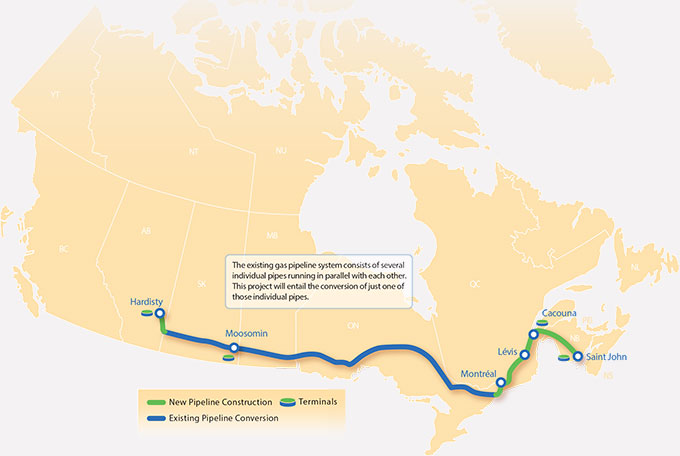April 8, 2015
The proposed Energy East pipeline has been the focus of much debate in recent months.
The Energy East project would connect Alberta to New Brunswick with a 4,600-kilometre pipeline capable of carrying 1.1 million barrels of oil each day. About 70 per cent of the pipeline would involve converting portions of an existing natural gas pipeline system, the Canadian Mainline. This conversion accounts for 95 per cent of the proposed project in Ontario, with new construction mostly occurring near the Quebec border.
The proposed route of the Energy East pipeline: 
Energy East would clearly benefit other regions of the country. As an oil producer, Alberta would be able to sell product at higher prices; and refiners and shippers in provinces such as New Brunswick could benefit from improved access to Western Canadian oil. When it comes to Ontario, TransCanada, the developer, has highlighted large economic benefits for the province, but our analysis indicates that potential economic costs could outweigh these benefits.
Claims about an economic boon from building Energy East don’t take into account important economic costs for Ontario that could result from the new pipeline. These might include increased GHG emissions; changes to energy flows that could raise the cost of natural gas supply for Ontarians; and a possible increase in the Canadian-U.S. exchange rate, which hurts Ontario exporters. These longer-term economy-wide impacts are hard to predict and far from certain, but they represent a real risk that should be weighed against potential benefits.
In addition, the benefits that TransCanada promotes rest on a type of economic impact assessment called Input/Output Modelling that can inflate benefits. Input/Output analysis only takes into account spending on the project, and assumes spending is inherently beneficial, without taking into account opportunity costs or the impact of the project or spending on the economy at large.
To see how just one of these wider economic costs could greatly affect the cost-benefit calculations for Ontario, we modelled the potential effect of the pipeline on the Canadian-U.S. exchange rate. According to our model, the increase in net exports of oil and refined petroleum products resulting from Energy East would likely lead to an increase in the Canadian dollar of between 1.2 cents U.S. and 2.5 cents U.S. Because Ontario relies so heavily on trade with the U.S. — nearly 80 per cent of provincial exports are destined for the U.S. — a higher loonie could mean $5.4 billion in reduced GDP per year for the province. That’s equivalent to:
Claims about an economic boon don’t take into account important economic costs for Ontario that could result from the new pipeline.
- A loss of around 50 per cent of GDP from the manufacturing or the finance and insurance sectors
- A 90 per cent reduction in the GDP contributed by the construction sector.[1]
The Energy East project has the potential to bring significant economic growth and job creation benefits to Canada and Ontario. However, the assumptions about these potential economic benefits need to be viewed critically and weighed against potential costs before decisions are made.
Note:
[1] Results calculated from Statistics Canada Table 379-0028 v54256022, v62356067, v54256021, v54256033
More related to this topic
Authors
Richard Carlson
Rob Dorling
Release Date
April 8, 2015






